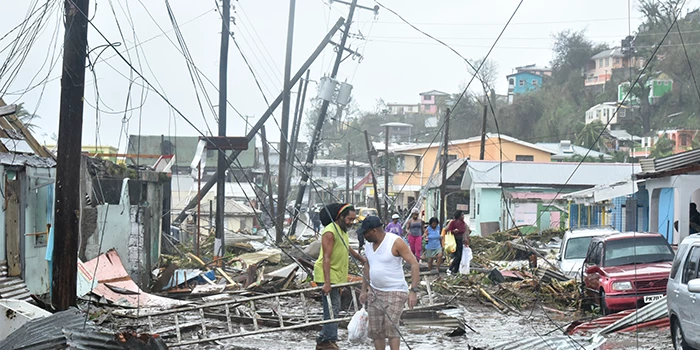
Hurricanes Irma and Maria recently devastated the Caribbean region. Infrastructure in Dominica was severely damaged and the country suffered a total loss of its annual agricultural production. The entire population of Barbuda had to be evacuated to Antigua and other islands. Estimates by the World Bank indicate that Irma caused damages equivalent to 14 percent of GDP for Antigua and Barbuda, and up to 200 percent of GDP for Dominica. The increasing frequency of hurricanes poses a threat to the economic development and wellbeing of 40 million people living in the region.
The World Bank and other development institutions acted quickly by offering support to assess damages and losses, respond to the disaster, and assist with recovery by delivering financial packages and supporting emergency operations. However, in the longer term, the focus is on building the resilience of these small island states to natural disasters.
Data: critical for responding to disasters, but also vulnerable to them
Systems of national statistics can provide critical information about the extent of a disaster, help guide recovery operations, and assess the preparedness of countries to future shocks. At the same time, the reliance of National Statistical Offices (NSOs) on local IT infrastructure makes them highly vulnerable to natural disasters. Computers, servers, and networks cannot operate without power; flooding and high humidity destroys hardware and storage media; looting and breaking into abandoned buildings puts sensitive information at the risk of falling into the wrong hands. Fortifying NSO buildings to withstand Category 5 hurricanes and enabling the offices to continue functioning afterwards is prohibitively expensive. Even if such structures were built, staffing would remain an issue, particularly if the entire population of the country was evacuated (as in case of Barbuda).
Cloud computing provides a very effective way to resolve that problem at a small fraction of the cost.
Cloud computing can mitigate some risks but why isn’t it more widely used?
Data stored on the cloud can be replicated automatically to multiple geographical locations, thus mitigating risks posed by natural disasters or political unrest. Cloud computing service providers operate at such a large scale (tens of thousands of servers on server farms) that per server costs of support, security, and maintenance become negligible. Few of the richest countries in the world maintain standards comparable to those of the largest international cloud providers, i.e., Amazon Web Services, Microsoft Azure, and Google.
Why then are the Caribbean NSOs not using these high quality, reliable and affordable services? We see three main reasons. First, while cloud computing is being widely commoditized, moving old infrastructure and processes to the cloud is still a technically challenging and risky process that requires a high level of IT expertise to manage. Second, there is a perception among many national statisticians that data privacy, data anonymity, and data residency laws prohibit storing data outside the country where the data originates. Finally, the procurement policies and practices of local governments are not designed to deal effectively with international cloud providers.
A standard approach can give cloud computing a head start in government
The Cloud for Development project (C4D) is designed to address these challenges and help move NSOs in developing countries to the cloud.
The C4D project originated in the World Bank as a collaboration between the Development Data Group (DECDG) and Information and Technology Solutions (ITS). The idea of C4D is to work jointly with large international cloud providers to develop the technical specifications as well as the legal and procurement procedures to support NSOs in adopting cloud technology. Several pilots are planned in different regions of the world to validate the technology and approach. Once tested in pilot environments, the specifications will be submitted to an independent third party (e.g. the International Organization for Standardization (ISO)) for certification of the proposed solution in terms of data security, reliability, data access and other standards. The certified specifications and designs will be made available to the public under an open source license.
Countries could then use these specifications to procure and deploy the appropriate cloud based solutions from the major commercial cloud providers. The selected provider would negotiate a service contract with the local government. The World Bank could provide technical and legal assistance to the countries who want to adopt the C4D approach. Part of the Bank’s role could include working with the NSOs and cloud providers to build local support capacity in IT and cloud computing as part of the overall implementation.
A public-private partnership for resilient digital infrastructure
This is a win for everybody involved. Countries can avoid developing complex, expensive, and duplicative technical specifications by relying on the certified open source documentation created by C4D. Commercial cloud providers can increase their customer reach by creating a standardized set of product offerings tailored for NSOs and related agencies. If common standards are developed and adopted, commercial cloud providers can use the same framework in many countries, bearing only marginal costs of fine-tuning for the requirements of a particular country. Finally, the World Bank will advance its mission by empowering developing countries with the latest technologies, promoting standards and best practices as global public goods, and increasing the local Statistical and IT service capability and capacity.
The World Bank has signed a Public-Private Partnership Memorandum of Understanding (MOU) with Amazon Web Services (AWS), and is in the process of negotiating similar MOUs with other large commercial cloud providers to collaborate on C4D. Many content providers have expressed interest in joining the project, including ESRI, one of the world leaders in GIS technology. Several months before Irma and Maria wreaked havoc in the region, the OECS Secretariat approached the World Bank with a proposal for ten OECS countries to participate in the pilot of C4D. The events of the recent weeks reinforced the urgency of building resilient infrastructure for the national statistics offices in the region.
Testing Cloud for Development in the Caribbean
A workshop on C4D, scheduled for mid-November in St. Lucia, will bring together the World Bank technical and legal team, AWS experts in data security and cloud infrastructure, GIS experts from ESRI, representatives from Statistics Canada and the OECS secretariat, and delegations from at least 11 Caribbean countries. The workshop will initiate a pilot deployment of cloud infrastructure by AWS that the OECS countries will use for a year in parallel to their existing systems before they decide whether to switch to the cloud.
If C4D progresses as planned, the Caribbean NSOs could be fully prepared for the next hurricane season. By storing and analyzing data in the cloud, the NSOs will be independent of the local conditions because their highly-encrypted data will be replicated on servers with wide geographic diversity (e.g in Dublin and Sao Paulo). NSO staff will be able to securely access their data from anywhere in the world, even if the local offices of the NSO are destroyed or inaccessible. The cloud will also facilitate NSO access to global geo-spatial resources, climate databases, real time high-resolution satellite imagery, and high-power computing capabilities such as machine learning and artificial intelligence.
Combining country data with global data sources and cloud computing capabilities will allow countries to monitor the conditions on the ground in real time and provide their government and international agencies with timely, precise information on the impact of a hurricane or other locally disruptive events.
We hope the future of Caribbean statistics will be “cloudy”.



Join the Conversation